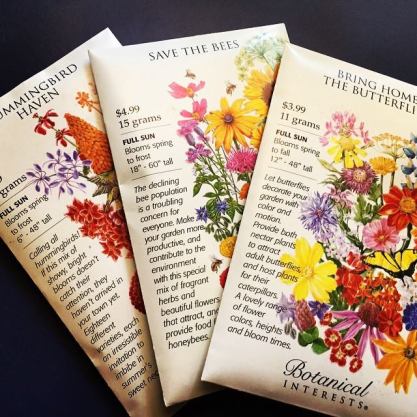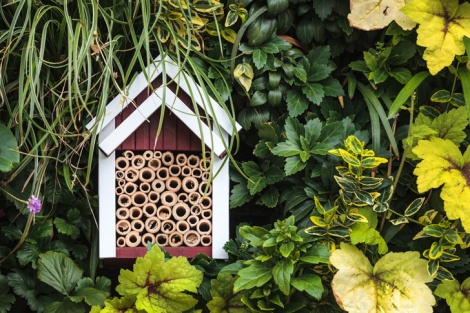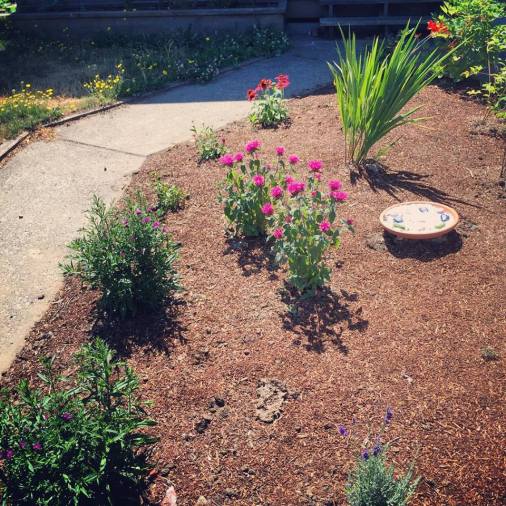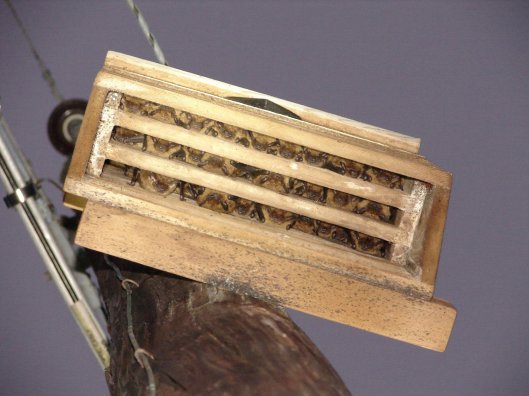Tags
aphids, bats, bees, birds, butterflies, butterfly, honey bees, ladybugs, mosquitoes, organic gardening, pest control, pollinators
Sometimes we think of all bugs, birds, and bees as pests, regardless of whether they’re actually doing anything detrimental to our gardens or to us. But they’re not actually all bad, and some are downright good to attract to your home through creating a habitat and using careful organic pest control.

The seed packets I have for planting a couple of flower beds next year.
My perennial garden is already geared towards attracting some of these beneficial and often beautiful critters, and I’ll be adding in a couple more flower beds in my front yard with the same purpose next spring. It’s particularly important to attract pollinators for a thriving garden.
So, let’s talk about some of the good critters you want in your yard. This isn’t at all comprehensive, but it will give you a start.
Bees
This is perhaps the most obvious. Bees are currently experiencing high rates of colony collapse disorder, which is the phenomenon that occurs when the majority of worker bees in a colony disappear and leave behind a queen, plenty of food and a few nurse bees to care for the remaining immature bees and the queen. There are likely a myriad of causes, not the least of which being pathogens and parasites. It’s very possible that it’s not one single cause, but the stresses of multiple factors, that are creating this problem.
To help reduce stress and improve food sources for honey bees, the public is given the recommendation to
not to use pesticides indiscriminately. In particular, the public should avoid applying pesticides during mid-day hours, when honey bees are most likely to be out foraging for nectar and pollen on flowering plants.
In addition, the public can plant pollinator-friendly plants—plants that are good sources of nectar and pollen such as red clover, foxglove, bee balm, joe-pye weed, and other native plants.
Other options for helping bees out is to get a bee condo, which is a place where mason bees can lay their eggs for the winter. Mason bees, which are blue bees that look similar to wasps, sting very rarely, and it’s not a hive so you don’t have to worry about a large number of bees in your backyard. Or, if you have enough space, keep your own small hive. The honey and wax are very profitable if your hive produces well, and you can do a lot to ensure the well-being of your hive to the benefit of your neighborhood plants. Finally, in the interest of having clover available, plant an “eco-lawn” by mixing clover in with your grass. Not only does this attract bees, but it also feeds your lawn without requiring fertilizer since clover is a nitrogen-fixer (pulls nitrogen out of the air) and grass loves nitrogen.
Butterflies
Some butterfly species, like the monarch, have been negatively impacted in recent years as well. Much of this is a combination of habitat loss and indiscriminate use of pesticides. Butterflies are beautiful pollinators, although some lay eggs that hatch caterpillars that eat vegetables. One way to get around that while still encouraging butterflies is to plant flowers that are attractive for egg-laying and caterpillars, thereby letting the butterflies reproduce on those plants rather than on your broccoli. The seed packet pictured at the top includes flowers that are good for all life stages of multiple butterfly species.
Butterflies also have very specific needs for being able to drink; specifically, they can’t drink from deep water. In summer when there aren’t puddles readily available and most water sources which survive the heat are deep running water, it can become difficult for them to get water. Keeping a butterfly puddler or a butterfly feeder (or both) can make your yard especially attractive to these pretty critters. A butterfly puddler is a shallow dish with rocks and perhaps sand and which has very wet sand or a shallow puddle available. A butterfly feeder tends to be something like a sponge soaked in sugar-water placed on a dish hanging in a tree.
Birds
Although not necessarily a pollinator, and sometimes a berry-snatcher, birds are still wonderful natural pest control. They eat many of the bugs that like to eat your vegetables and flowers. Habitat destruction doesn’t do them any favors, either, so keeping some bird houses and a bird bath near your garden can be mutually beneficial. Bird seed may help too, for the times when the bugs are a little more scarce. Just remember to net your berries if the birds are stealing too many!
I particularly like hummingbirds. They’re so pretty, after all, and they drink nectar like butterflies.
Bats
Bats? Yes, bats.
Bats are wonderful pest control. Got a lot of mosquitoes? Get a bat house. Although they won’t eliminate the problem, they eat a tons of insects, which means they’ll certain reduce the problem. Bats are another one that are experiencing serious population losses and habitat destruction, so giving them a nice place to live from spring to fall can be very helpful to them.
A bat house much be placed 15-25 feet high in a sunny location (they like it warm so they can sleep snug). It can take some time to attract a bat family, and if there are no bats in the area it may just never happen. The house should be cleaned out during the winter when the bats leave to hibernate. I’m going to try putting them on either side of my two-story house. I’ve heard bats in the neighborhood, so I’m hopeful that I can get a family next spring.
Ladybugs
Ladybugs eat almost every garden pest there is. Seriously, if you look at a comprehensive list of garden pests and their natural predators, ladybugs are probably listed as a predator on at least 75%, and aren’t a garden pest at all.
 Ladybugs can be purchased, but that’s useless if they aren’t encouraged to stay in your area. An easy way to do this is to have a lady bug house. It looks similar to a mason bee condo, but the tubes can vary in size, where the mason bee tubes need to be sized very specifically. If there is a habitat and food available, you’ll soon have a ladybug haven. They, like most natural predators, won’t totally eliminate the pests they eat, but they’ll ideally keep them under control effectively enough that your vegetables can thrive anyways. They are especially well-known for eating aphids, which can decimate many types of plants, vegetable and otherwise.
Ladybugs can be purchased, but that’s useless if they aren’t encouraged to stay in your area. An easy way to do this is to have a lady bug house. It looks similar to a mason bee condo, but the tubes can vary in size, where the mason bee tubes need to be sized very specifically. If there is a habitat and food available, you’ll soon have a ladybug haven. They, like most natural predators, won’t totally eliminate the pests they eat, but they’ll ideally keep them under control effectively enough that your vegetables can thrive anyways. They are especially well-known for eating aphids, which can decimate many types of plants, vegetable and otherwise.
Remember, with all of these critters, avoiding pesticides or using only very specific organic pesticides is important. Healthy plants and an environment that attracts natural, plant-friendly predators will go a long way in reducing or eliminating any need for pesticides or herbicides. If something more intensive is required, look to solutions like neem oil, which kills only insects that eat plant matter and can also kills certain molds and fungus, or BT, which specifically targets caterpillars that might be decimating your leafy greens and effects almost nothing else.



Pingback: Good Critters | Our Little Urban Homestead | WORLD ORGANIC NEWS